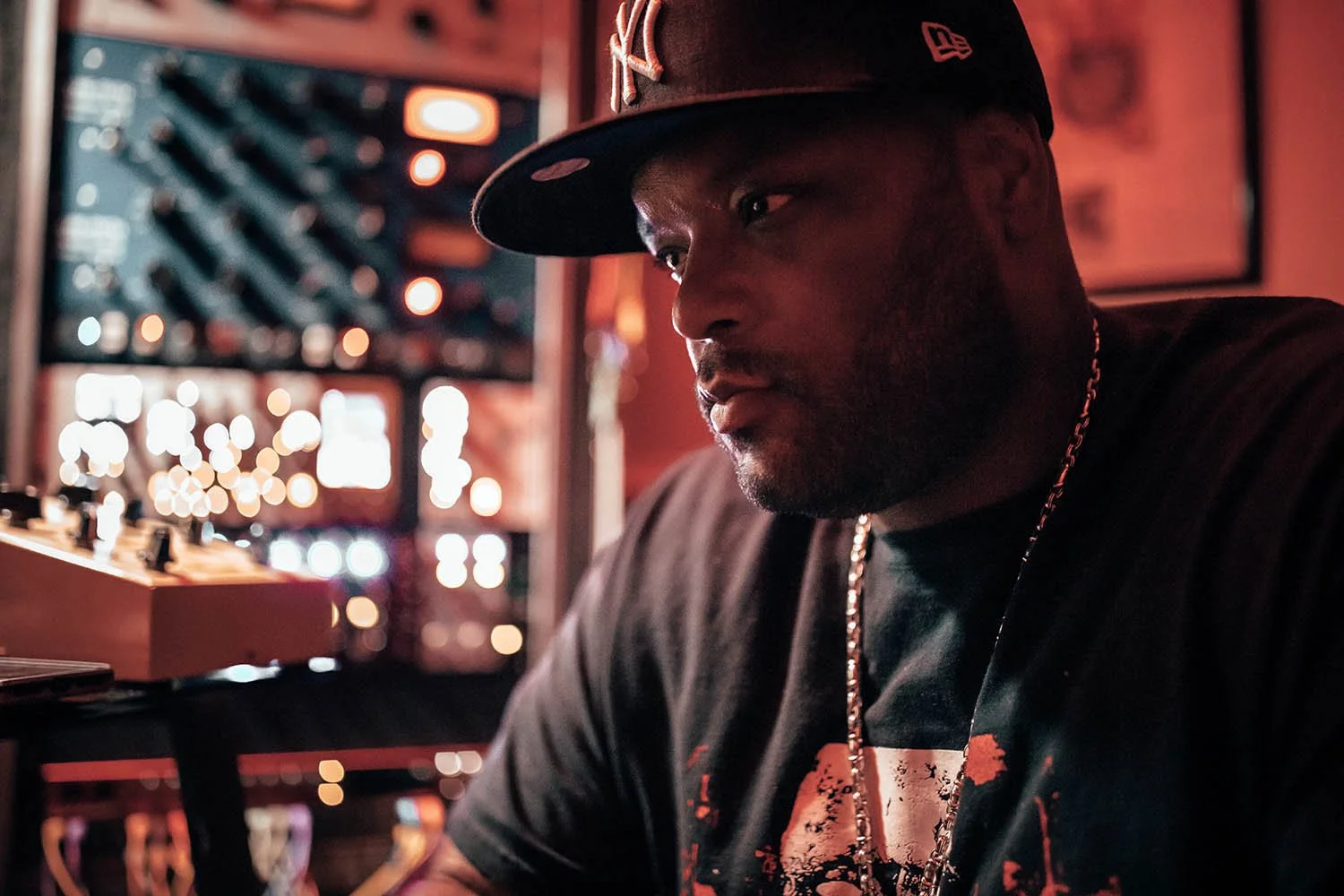MIXING MULTI-PLATINUM HITS - ROB KINELSKI
How Rob Kinelski drove his Dangerous Music gear to mix multi-platinum hits for Billie Eilish and countless other artists.
By Brooke Bilyj
Kinelski cut his musical chops mixing on big studio consoles, while engineering for artists like Beyonce, Rihanna, Joey Bada$$, and Big Sean. But when mixing on SSL desks became cumbersome for the quick tweaks his clients wanted, Kinelski decided to streamline his studio setup using high-end engineering equipment from Dangerous Music.
In fact, it was on Dangerous gear that Kinelski captured the dynamic sounds that catapulted the hauntingly eccentric Billie Eilish to her record-breaking GRAMMY-sweeping success. Kinelski’s work on Eilish’s debut album, “When We Fall Asleep, Where Do We Go?” nabbed awards last year for Album of the Year, Best Pop Vocal Album, Best Engineered Album (Non-Classical), and Record of the Year for the hit single, “Bad Guy.”
“I’m very fortunate to be part of such a cool project with such good artists. The amount of influence Billie’s had on pop music has inspired a lot of people,” says Kinelski—and now, a lot of those inspired musicians are calling him to mix their albums, too—opening him up to a spectrum of exciting new projects.
Leveraging his hip-hop/R&B roots with the capabilities of Dangerous gear, Kinelski is building on his recent success to shatter standard genres and help young artists shape the future of music. Here’s how he’s using Dangerous equipment to push the industry forward.
From the board to the box
After studying at the SAE Institute in New York, Kinelski joined Sony Music Studios, where he worked on Beyonce’s GRAMMY-winning 2006 album, “B-Day,” which ushered him into more high-profile sessions. When Sony Studios closed in 2007, Kinelski freelanced for a couple years before moving to L.A., where he connected with rapper/producer No ID to work with artists like Big Sean, Nas, and Common—building his R&B repertoire.
“As we were going from studio to studio, trying to pull up different sessions, I found that the workflow on the console was terribly time-consuming,” says Kinelski, who mainly mixes in the box but uses a chain of analog outboard equipment. “The recall on a console was a nightmare because the client had gotten used to mixing in the box. They’d want me to turn the background vocal up a quarter dB, and it’s like, come on! You can’t just tweak one little thing really quick on a console. The recall would come back pretty close, but it wasn’t exactly the same. They would hear the difference, and they’d be frustrated. I decided I wouldn’t miss mixing on a console again.”
To alleviate his mixing frustrations, engineering friend, Dave Kutch brought Kinelski a Dangerous 2-BUS summing mixer to help him mix seamlessly from the board to the box. Kinelski ran a test track between the console and the 2-BUS, and instantly chose the Dangerous mix.
“I liked it because it gave me the analog feeling of a console, but I could keep the workflow in the box,” says Kinelski, who was working on Big Sean’s second major album, “Hall of Fame,” when he started using Dangerous gear. “I started using the 2-BUS in big studios because I didn’t have time to recall the board if people bumped into faders. It became part of my workflow, and I was able to work much faster and still maintain some character.”
As efficient as the 2-BUS was inside large studios, it was essential when Kinelski went out on his own in 2009. “I had an iMac, the 2-BUS, and the Dangerous MONITOR ST,” he says, “and I remember sitting there going, ‘I can’t believe I’m going to mix records on an iMac,’ after starting my career on big consoles. I was really nervous, but I did it, and my clients approved.”
The accident behind “Bad Guy”
As his business picked up, Kinelski added the Dangerous Music COMPRESSOR to his studio next. He routed his mixes through the 2-BUS, then into the COMPRESSOR, then back into Pro Tools—streamlining his master bus chain without sacrificing sound quality.
“Dangerous allows me to take stems that are already in a cool place, and just make them better,” Kinelski says. “There’s more headroom to work with, more depth, and more of a musical vibe. It’s kind of like picking the right canvas for a painting; the Dangerous gear creates the atmosphere that I get to work within—but without taking away the focus from the music, so I can maintain the integrity.”
This transparent, punchy sound was exactly what Billie Eilish was looking for when she entered the scene with her breakthrough song, “Ocean Eyes,” on SoundCloud. Although her older brother, Finneas O’Connell, produces all of her music, the siblings sought Kinelski’s mixing expertise at the recommendation of their mastering engineer, John Greenham (who mastered LP’s album, “Lost On You,” which Kinelski also mixed). Leveraging his hip-hop experience with massive low-ends, Kinelski brought a dynamic sound to the rising star’s distinctively minimalist production style.
After mixing the song “Bellyache,” Billie’s follow-up to “Ocean Eyes,” one single led to another, and then Kinelski mixed her EP, “Don’t Smile at Me,” in August 2017. By the time he started mixing her debut full-length album, Kinelski had just welcomed his first daughter, Ruby.
Serendipitously, while he was working through the sleepless “fog” of new fatherhood, Kinelski forgot to change the compression settings before printing a mix. This happy engineering accident spawned the unique sonic depth of Billie’s first No. 1 hit single, “Bad Guy.”
“What I would normally do is crank up the ratio really high, so I can audibly hear the aggressive compression, and then I would tweak my release and attack times to have a musical feel, and then back off on the threshold and the ratio,” says Kinelski, who usually has his compressor set at 4:1.
“But I was mixing the album in this newborn-baby fog, and I did “Bad Guy” with a 10:1 ratio, and I guess I forgot to turn it back down,” he says. “I looked down after I printed and sent the first pass, and I was like, ‘Oh, crap, I left it at 10 to 1!’ But the compression was so musical that it worked. It sounded cool, and the mix got approved, so I didn’t have a chance to change it—and it ended up being her biggest song of all time.”
EDIT: ( COMPRESSOR was set to a 20:1 ratio during this mix )
Finneas would send stems to Kinelski that the siblings recorded in a bedroom studio inside their parents’ house. As producer, Finneas already made deliberate decisions with Billie’s intimate whispers and dry vocal effects, and they counted on Kinelski to subtly sweeten up the tracks and get the bass drum banging.
“I would mix into the 2-BUS pretty aggressively, and the COMPRESSOR just added this layer of glue, but it was very transparent,” Kinelski says. “It tightened it up, but didn’t choke it. It’s clean, but not sterile. Dangerous managed to find a nice balance, so the gear did its job in a musical way without stepping on her progressive sound.”
Breaking beyond genres
At age 17, Eilish became the youngest artist to win all four major GRAMMY categories—Best New Artist, Record of the Year, Song of the Year, and Album of the Year—all in the same year. As is Kinelski’s tradition after every big album release, he rewarded himself with another new piece of gear for his studio: The Dangerous CONVERT-AD+.
After hearing the difference over his previous audio interface, Kinelski soon added more Dangerous converters to his chain—including the CONVERT-2 and the CONVERT-8. Along the way, he also upgraded to the Dangerous 2-BUS+ for summing.
“When I swapped from the Avid HD I/O to the CONVERT-8 and compared the two, I just thought it felt better overall,” he says. “The difference I notice is that mixes have been getting done faster because the Dangerous converters add an element of depth and clarity. They also seem to increase the size of my sound-space. The low end is tighter. The high end is cleaner. The mid-range is more open and clear.”
Kinelski’s clients agree, as artists from around the world are reaching out for his sonic touch on their projects. “They keep calling,” he says, “and everyone’s happy. We get fewer revisions, and we get to the endpoint quicker.”
Besides scoring another GRAMMY win this year for Billie’s song, “Everything I Wanted,” Kinelski has been racking up hits for a spectrum of stars. He was up for his first Latin GRAMMY this year, for Karol G’s song, “Tusa,” with Nicki Minaj, which was nominated for Record of the Year. Karol G’s song, “Bichota,” reached No. 12 on the Billboard Global Chart excluding U.S. rankings, and hit No. 5 on the Hot Latin Songs chart.
Kinelski’s recent projects range from Karol G’s Colombian reggaeton, to the gospel music of a group called For King & Country, to the lo-fi trip hop of Japanese singer-songwriter Joji, to the soulful Americana roots rock of Anderson East.
“I’m getting a lot of different work all over the place, in all different genres, which has been really fun,” Kinelski says. “That’s the career I always wanted, was not to be boxed into any genre, but to do all different types of music. The new generation doesn’t care about genre as much as we all used to, because the playlist killed the genre. As an engineer, it’s more freeing and exciting to work outside the lines.”
Whatever genre-defying sound he’s trying to create for his clients, Kinelski relies on Dangerous gear to push music to new places. “Dangerous is on the pulse of where the industry is going,” he says. “Their equipment is ahead of its time, and it’s the best stuff you can get at this price point and above. If you care about fidelity, there’s not really anywhere else to go.”
As for Kinelski’s next big hit, he’s expecting his new fatherhood fog to work its good fortune again. A few weeks before this interview, Kinelski welcomed his second daughter, Pepper, to the family. Since he mixed Billie’s record-breaking album right after Ruby was born, he jokes that, “There’s a lot of pressure on Pepper now for what we’re going to do next.”







